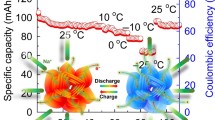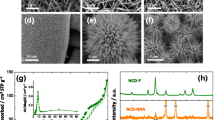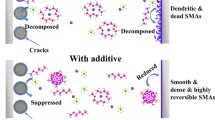Abstract
MoO3 has become a very promising energy storage material owing to its high theoretical capacity and layered structure. However, MoO3 suffers from low specific capacitance and fast degradation performance due to pulverization caused by volume change during discharge and charge process. Here, we report the MoO3 nanoplates (MoO3 NPs) from Mo-based metal–organic frameworks (Mo-MOFs) via a facile heating treatment. When used as an anode in sodium-ion batteries (SIBs), the material showed 154 mAh g−1 superior discharge capacity at 50 mA g−1 after 1200 cycles. Even at 500 mA g−1, it also showed 217 mAh g−1 high specific capacity after 500 cycles. This specific MoO3 material design strategy offers suitable conditions for relieving the volume expansion and provides multiple channels for Na+ transport and electron transfer in MoO3 during discharge and charge process. This work highlights the importance of MoO3 nanoplates in preventing the pulverization caused by volume expansion in SIBs.







Similar content being viewed by others
References
Tarascon JM (2010) Is lithium the new gold? Nat Chem 2:510
Slater MD, Kim D, Lee E, Johnson CS (2013) Sodium-ion batteries. Adv Funct Mater 23:947–958
Li W, Hu S, Luo X, Li Z, Sun X, Li M, Liu F, Yu Y (2017) Confined amorphous red phosphorus in MOF-derived N-doped microporous carbon as a superior anode for sodium-ion battery. Adv Mater 29:1–8
Liu H, Jia M, Zhu Q, Cao B, Chen R, Wang Y, Wu F, Xu B (2016) 3D-0D graphene-Fe3O4 quantum dot hybrids as high-performance anode materials for sodium-ion batteries. ACS Appl Mater Interfaces 8:26878–26885
Liu Y, Cheng Z, Sun H, Arandiyan H, Li J, Ahmad M (2015) Mesoporous Co3O4 sheets/3D graphene networks nanohybrids for high-performance sodium-ion battery anode. J Power Sources 273:878–884
Wang B, Wang G, Cheng X, Wang H (2016) Synthesis and electrochemical investigation of core-shell ultrathin NiO nanosheets grown on hollow carbon microspheres composite for high performance lithium and sodium ion batteries. Chem Eng J 306:1193–1202
Wang Y, Deng Q, Xue W, Jian Z, Zhao R, Wang J (2018) ZnO/rGO/C composites derived from metal–organic framework as advanced anode materials for Li-ion and Na-ion batteries. J Mater Sci 53:6785–6795. https://doi.org/10.1007/s10853-018-2003-3
Sreedhara MB, Santhosha AL, Bhattacharyya AJ, Rao CNR (2016) Composite of few-layer MoO3 nanosheets with graphene as a high performance anode for sodium-ion batteries. J Mater Chem A 4:9466–9471
Riley LA, Lee SH, Gedvilias L, Dillon AC (2010) Optimization of MoO3 nanoparticles as negative-electrode material in high-energy lithium ion batteries. J Power Sources 195:588–592
Xia W, Xu F, Zhu C, Xin HL, Xu Q, Sun P, Sun L (2016) Probing microstructure and phase evolution of α-MoO3 nanobelts for sodium-ion batteries by in situ transmission electron microscopy. Nano Energy 27:447–456
Spahr ME, Novak P, Haas O, Nesper R (1995) Electrochemical insertion of lithium, sodium, and magnesium in molybdenum(Vi) oxide. J Power Sources 54:346–351
McDowell MT, Xia SM, Zhu T (2016) The mechanics of large-volume-change transformations in high-capacity battery materials. Extreme Mech Lett 9:480–494
Wu K, Zhan J, Xu G, Zhang C, Pan D, Wu M (2018) MoO3 nanosheet arrays as superior anode materials for Li- and Na-ion batteries. Nanoscale 10:16040–16049
Ding J, Abbas SA, Hanmandlu C, Lin L, Lai C, Wang P, Li L, Chu C, Chang C (2017) Facile synthesis of carbon/MoO3 nanocomposites as stable battery anodes. J Power Sources 348:270–280
Zhang X, Fu C, Li J, Yao C, Lu T, Pan L (2017) MoO3/reduced graphene oxide composites as anode material for sodium ion batteries. Ceram Int 43:3769–3773
Yang C, Lu H, Li C, Wang L, Wang H (2018) Spatially-confined electrochemical reactions of MoO3 nanobelts for reversible high capacity: critical roles of glucose. Chem Eng J 337:1–9
Wang Z, Madhavi S, Lou XW (2012) Ultralong α-MoO3 nanobelts: synthesis and effect of binder choice on their lithium storage properties. J Phys Chem C 116:12508–12513
Xia Q, Zhao H, Du Z, Zeng Z, Gao C, Zhang Z, Du X, Kulka A, Świerczek K (2015) Facile synthesis of MoO3/carbon nanobelts as high-performance anode material for lithium ion batteries. Electrochim Acta 180:947–956
Lee S-H, Kim Y-H, Deshpande R, Parilla PA, Whitney E, Gillaspie DT, Jones KM, Mahan AH, Zhang S, Dillon AC (2008) Reversible lithium-ion insertion in molybdenum oxide nanoparticles. Adv Mater 20:3627–3632
Jiang Y, Sun M, Ni J, Li L (2019) Ultrastable sodium storage in MoO3 nanotube arrays enabled by surface phosphorylation. ACS Appl Mater Interfaces 11:37761–37767
Meduri P, Clark E, Kim JH, Dayalan E, Sumanasekera GU, Sunkara M (2012) MoO3−x nanowire arrays as stable and high-capacity anodes for lithium ion batteries. Nano Lett 12:1784–1788
Cao D, Dai Y, Xie S, Wang H, Niu C (2018) Pyrolytic synthesis of MoO3 nanoplates within foam-like carbon nanoflakes for enhanced lithium ion storage. J Colloid Interface Sci 514:686–693
Chen J, Lou X (2012) SnO2 and TiO2 nanosheets for lithium-ion batteries. Mater Today 15:246–254
Cao X, Zheng B, Shi W, Yang J, Fan Z, Luo Z, Rui X, Chen B, Yan Q, Zhang H (2015) Reduced graphene oxide-wrapped MoO3 composites prepared by using metal-organic frameworks as precursor for all-solid-state flexible supercapacitors. Adv Mater 27:4695–4701
Martin-Zarza P, Arrieta J, MuAoz-Roca M, Gili P (1993) Synthesis and characterization of new octamolybdates containing imidazole, 1-methyl- or 2-methyl-imidazole co-ordinatively bound to molybdenum. J Chem Soc Dalton Trans. https://doi.org/10.1039/DT9930001551
Lou X, Zeng H (2002) Hydrothermal synthesis of α-MoO3 nanorods via acidification of ammonium heptamolybdate tetrahydrate. Chem Mater 14:4781–4789
Li S, Hou H, Huang Z, Liao H, Qiu X, Ji X (2017) Alternating voltage introduced [001]-oriented α-MoO3 microrods for high-performance sodium-ion batteries. Electrochim Acta 245:949–956
Cai Y, Yang H, Zhou J, Luo Z, Fang G, Liu S, Pan A, Liang S (2017) Nitrogen doped hollow MoS2/C nanospheres as anode for long-life sodium-ion batteries. Chem Eng J 327:522–529
Qiu J, Yang Z, Li Y (2015) N-doped carbon encapsulated ultrathin MoO3 nanosheets as superior anodes with high capacity and excellent rate capability for Li-ion batteries. J Mater Chem A 3:24245–24253
Ji H, Liu X, Liu Z, Yan B, Chen L, Xie Y, Liu C, Hou W, Yang G (2015) In situ preparation of sandwich MoO3/C hybrid nanostructures for high-rate and ultralong-life supercapacitors. Adv Funct Mater 25:1886–1894
Ma F, Yuan A, Xu J, Hu P (2015) Porous alpha-MoO3/MWCNT nanocomposite synthesized via a surfactant-assisted solvothermal route as a lithium-ion-battery high-capacity anode material with excellent rate capability and cyclability. ACS Appl Mater Interfaces 7:15531–15541
Hariharan S, Saravanan K, Balaya P (2013) α-MoO3: a high performance anode material for sodium-ion batteries. Electrochem Commun 31:5–9
Liu Y, Zhang B, Xiao S, Liu L, Wen Z, Wu Y (2014) A nanocomposite of MoO3 coated with PPy as an anode material for aqueous sodium rechargeable batteries with excellent electrochemical performance. Electrochim Acta 116:512–517
Guo J, Sun A, Chen X, Wang C, Manivannan A (2011) Cyclability study of silicon–carbon composite anodes for lithium-ion batteries using electrochemical impedance spectroscopy. Electrochim Acta 56:3981–3987
Xu Y, Zhou M, Wang X, Wang C, Liang L, Grote F, Wu M, Mi Y, Lei Y (2015) Enhancement of sodium ion battery performance enabled by oxygen vacancies. Angew Chem Int Ed Engl 54:8768–8771
Li Y, Wang D, An Q, Ren B, Rong Y, Yao Y (2016) Flexible electrode for long-life rechargeable sodium-ion batteries: effect of oxygen vacancy in MoO3−x. J Mater Chem A 4:5402–5405
Liu T-C, Pell WG, Conway BE, Roberson SL (1998) Behavior of molybdenum nitrides as materials for electrochemical capacitors: comparison with ruthenium oxide. J Electrochem Soc 145:1882–1888
Wang J, Polleux J, Lim J, Dunn B (2007) Pseudocapacitive contributions to electrochemical energy storage in TiO2 (Anatase) nanoparticles. J Phys Chem C 111:14925–14931
Chao D, Zhu C, Yang P, Xia X, Liu J, Wang J, Fan X, Savilov SV, Lin J, Fan HJ, Shen ZX (2016) Array of nanosheets render ultrafast and high-capacity Na-ion storage by tunable pseudocapacitance. Nat Commun 7:12122
Mukhopadhyay A, Sheldon BW (2014) Deformation and stress in electrode materials for Li-ion batteries. Prog Mater Sci 63:58–116
Zhao Y, Ding C, Hao Y, Zhai X, Wang C, Li Y, Li J, Jin H (2018) Neat design for the structure of electrode to optimize the lithium-ion battery performance. ACS Appl Mater Interfaces 10:27106–27115
Yan P, Zheng J, Gu M, Xiao J, Zhang J, Wang C (2017) Intragranular cracking as a critical barrier for high-voltage usage of layer-structured cathode for lithium-ion batteries. Nat Commun 8:14101
Kim H, Cook J, Lin H, Ko J, Tolbert S, Ozolins V, Dunn B (2017) Oxygen vacancies enhance pseudocapacitive charge storage properties of MoO3−x. Nat Mater 16:454–460
Acknowledgements
This study was funded by the National Natural Science Foundation of China (No. 41572034) and the Guangxi Natural Science Foundation (No. 2018GXNSFAA294012).
Author information
Authors and Affiliations
Corresponding authors
Ethics declarations
Conflict of interest
The authors declare that they have no conflict of interest.
Additional information
Publisher's Note
Springer Nature remains neutral with regard to jurisdictional claims in published maps and institutional affiliations.
Electronic supplementary material
Below is the link to the electronic supplementary material.
Rights and permissions
About this article
Cite this article
Yang, C., Xiang, Q., Li, X. et al. MoO3 nanoplates: a high-capacity and long-life anode material for sodium-ion batteries. J Mater Sci 55, 12053–12064 (2020). https://doi.org/10.1007/s10853-020-04788-z
Received:
Accepted:
Published:
Issue Date:
DOI: https://doi.org/10.1007/s10853-020-04788-z




